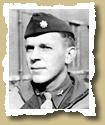| The Assault | Timeline | Maps | Men of D-Day | Photos |

|
It was common knowledge that
our Group was transferred from Sicily to England to participate
in the invasion of the European continent. Even the German radio
announced our arrival and welcomed us to the UK. Of course, they
also promised that we would all be shipped home in wooden boxes.
After arriving in England, we soon adapted to our new country and in some ways because of the many similarities we almost felt as though we had gone home. Our days and nights were filled with flying supply missions in England and Scotland and many night formation training flights. One of the night formation flights ended in tragedy with two of our planes colliding in mid-air. The lead plane, that had the Group Commander as an observer, was hit by a plane of the following element at a turn around a beacon. All personnel on both planes were killed. The group commander, Col. Burton Fleet, had been my squadron commander prior to his transfer to group headquarters. This accident naturally effected us all. There was deep sorrow for the loss of our friends and also the heightened awareness that the night formation flying, required for the invasion, could be even more dangerous. One day we received visitors. They were members of the 82nd Airborne who set up camp on our field at Cottesmore. There was no doubt now that we would be participating in the invasion! We would be taking them on a one way trip to some undisclosed location someplace on the continent. We certainly did not envy their position. Their camp was isolated and we didn't get to talk with them until just before they boarded our planes. The less any one individual knew about the whole operation, the better the chance to keep the secret from the enemy. Because I was a squadron
commander, I was briefed on the operation sometime before the rest
of the squadron. I don't remember the exact sequence of the activities
prior to the invasion. We did go to a nearby airfield to listen
to a talk and receive a send off by General Eisenhower. Then came
the postponement of the mission for a day due to the weather. I
breathed a sigh of relief but realized it only meant another day
of anxiety! We crossed the channel with no problems; flying at about 2000 feet above the water. As we approached the coast of Normandy, we found a cloud formation had formed just below our altitude. My first thought was that the Germans had spread poison gas in the area. The cloud formation appeared to lay in rows and looked to me as though it might have been spread by airplanes. I quickly realized that my imagination was working overtime! The clouds were a natural formation and could have resulted from the planes that were ahead of us flying through nearly saturated air, causing it to condense into clouds. As we neared the drop zone, I was faced with an important decision! Was it better to drop down and fly through the clouds and risk having the formation break up with the possibility of mid air collisions or to stay above and drop the paratroopers at an altitude that would cause them to become widely separated? We soon picked up the radar signal from the pathfinders! At about five miles distance from the drop zone, the cloud layer ended and I could clearly see the lights set up by the pathfinders. I immediately closed the throttles and started to descend. I quickly realized that I had better use some power, for my formation was overtaking my plane. By the time we reached the drop zone we were a little above the 500 ft. altitude and a little faster than the desired speed for dropping the troops. However, it was, in my judgment, best to drop at this time rather than to circle and take the chance of colliding with the following formation. After dropping the troops we flew as low as possible and soon crossed the coast. I don't know if I dreamed this or not, but as we crossed the coast I thought that I could see trenches and soldiers. I don't remember seeing much ground fire. Compared to the second night over Sicily this was a "milk run". The remainder of the trip back to our base was uneventful. We all felt quite relieved to learn that there were few casualties. I believe that our group lost no airplanes that night. Several explanations are in order. The pathfinders were a group of troop carrier crews and paratroopers highly trained in navigation with the latest radar equipment. Prior to our drops they located the drop zones and set up lights and radar for our guidance to the drop zones. Our lead planes were equipped with Rebecca-Eureka radar that had a scope in the instrument panel giving direction and distance to the pathfinder's signal. Another explanation concerns our night formation flying. Each plane had three purple hooded lights on each wing and three on top of the fuselage. They were only visible from the rear quarter and were adequate so long as the formation was fairly tight. The exhaust pipes had flame arresters to avoid being seen from the ground and presenting a target. This account is only as accurate as my memory. I certainly did not make up this account. I believe it to be fairly true to the actual events. It was a night that many of us will never forget! My crew for this mission
NEPTUNE BIGOT are as follows: Benjamin Kendig (September 24, 2002) |
| |
